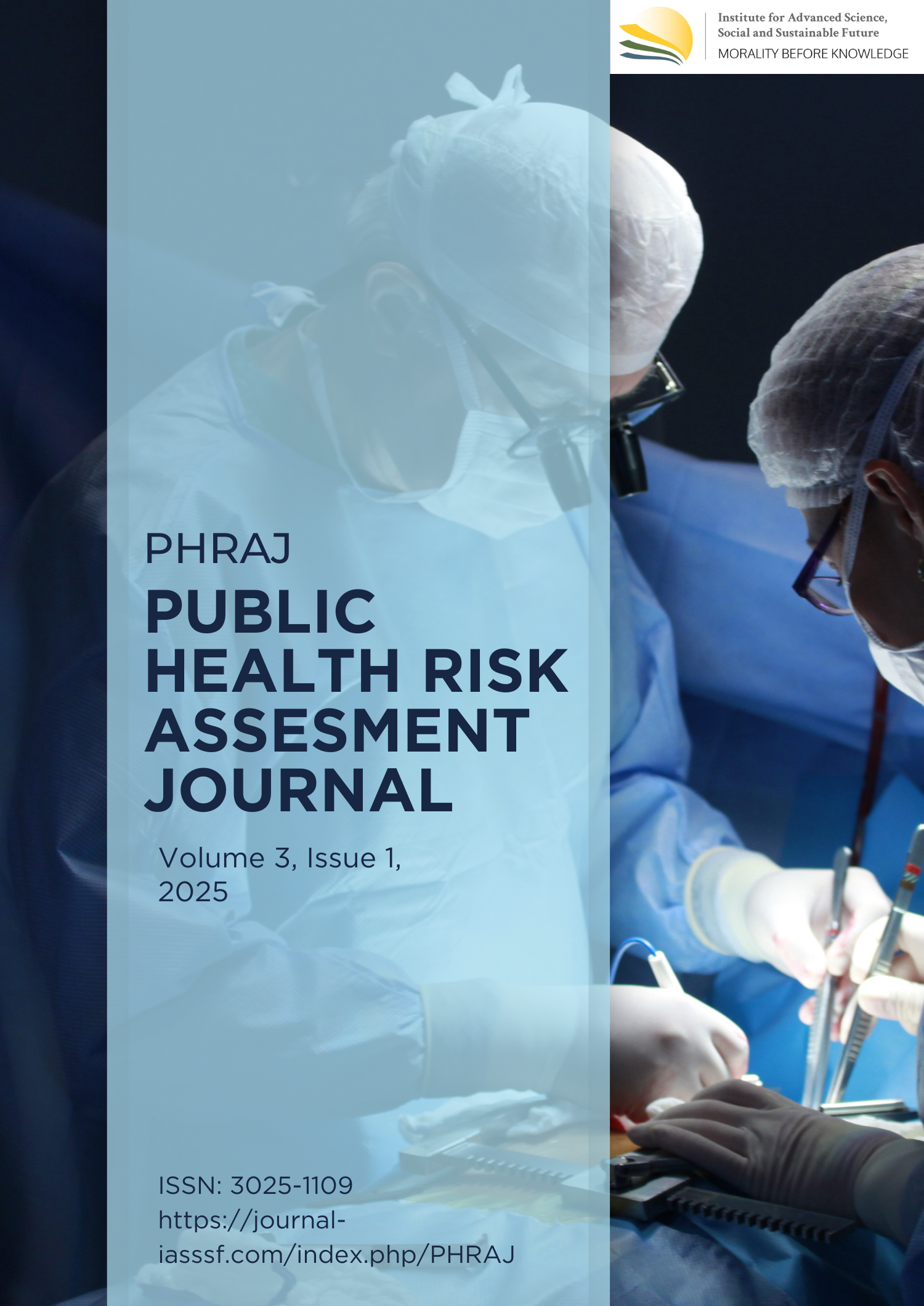Multifactorial analysis of diarrhea in children: Economic, environmental, and behavioral perspectives
DOI:
https://doi.org/10.61511/phraj.v3i1.2025.1955Keywords:
environmental sanitation, diarrhea, behaviorAbstract
Background: Diarrhea is a common illness among children, particularly in areas with inadequate environmental sanitation. This study seeks to examine the impact of economic status, environmental sanitation conditions, and defecation habits on the occurrence of diarrhea in children aged 5 to 11 years. Methods: The study employs an analytical observational design with a cross-sectional approach and includes 96 participants selected through purposive sampling. Data were analyzed using univariate methods, bivariate analysis with the Chi-Square test, and multivariate analysis with logistic regression. Findings: The findings revealed (1) a significant association between economic status and diarrhea incidence (p = 0.001); (2) a significant link between environmental sanitation and diarrhea cases (p = 0.000); (3) a notable relationship between defecation behavior and diarrhea incidence (p = 0.003); and a multivariate analysis confirmed a significant relationship between economic status, environmental sanitation, and defecation patterns with a p-value of 0.036. Conclusion: The goal is to gain deeper insights into the contributing factors of diarrhea and to support prevention and treatment strategies through economic development, sanitation awareness, and the promotion of healthy living. Novelty/Originality of this Article: This study offers an integrative analysis of economic, environmental, and behavioral factors affecting diarrhea in children, providing data-driven evidence to inform multifaceted public health interventions in sanitation-deficient areas.
References
Andarini, D., Novrikasari, N., Lestari, M., & Yeni, Y. (2021). Implementasi Gerakan Respon Diare pada Balita di Kecamatan Jejawi Kabupaten Ogan Komering Ilir. Jurnal Manajemen Kesehatan Yayasan RS.Dr. Soetomo, 7(1), 9. https://doi.org/10.29241/jmk.v7i1.558.
Azanaw, J., Malede, A., Yalew, H. F., & Worede, E. A. (2024). Determinants of diarrhoeal diseases among under five children in Africa (2013–2023): A comprehensive systematic review highlighting geographic variances, socioeconomic influences, and environmental factors. BMC Public Health, 24, 2399. https://doi.org/10.1186/s12889024199620
Azzahra, J., Bamahry, A. R., Pratama, A. A., Purnamasari, R., & Rasfayanah, R. (2023). Hubungan Asupan Serat dengan Kejadian Konstipasi pada Mahasiswa Fakultas Kedokteran Universitas Muslim Indonesia Angkatan 2020. Fakumi Medical Journal: Jurnal Mahasiswa Kedokteran, 3(1), 72–79. https://fmj.fk.umi.ac.id/index.php/fmj/article/view/181
Bandsma, R. H. J., Sadiq, K., & Bhutta, Z. A. (2019). Persistent Diarrhoea: Current Knowledge and Novel Concepts. Paediatrics and International Child Health, 39(1), 41–47. https://doi.org/10.1080/20469047.2018.1504412.
BPS Kabupaten Boyolali. (2023). Kabupaten Boyolali Dalam Angka,. BPS Kabupaten Boyolali.
BPS Jawa Tengah. (2023). Provinsi Jawa Tengah Dalam Angka 2023. Badan Pusat Statistik Provinsi Jawa Tengah.
David, N. (2023). Factors Affecting the Occurrence of Diarrhea in Children under the Age of Five at Western Uganda’s Fort Portal Regional Referral Hospital. NIJPP, 4(1), 1–12. https://doi.org/10.53089/medula.v14i9.1313
Fitriani, N., Darmawan, A., & Puspasari, A. (2021). Analisis Faktor Risiko Terjadinya Diare pada Balita di Wilayah Kerja Puskesmas Pakuan Baru Kota Jambi. Medical Dedication (medic) : Jurnal Pengabdian kepada Masyarakat FKIK UNJA , 4(1), 154–164. https://doi.org/10.22437/medicaldedication.v4i1.13472.
Freya, W. O. R., & Agusta, M. (2022). Hubungan Air Bersih Dan Sanitasi Lingkungan Terhadap Kejadian Luar Biasa Diare. Jurnal Endurance, 7(3), 615–626. https://doi.org/10.22216/jen.v7i3.1636.
Haryanto, H. D. W., & Siti, N. (2015). Sistem Deteksi Gangguan Depresi Pada Anak-Anak Dan Remaja. Jurnal Ilmiah Teknik Industri, 14(2). https://doi.org/10.23917/jiti.v14i2.998.
Herawati, E., & Utami, L. (2022). Internet Addiction Causes Problems Emotional And Behavior In Adolescents. Biomedika, 14(1), 74-80. https://doi.org/10.23917/biomedika.v14i1.17126.
Iryanto, A. A., Joko, T., & Raharjo, M. (2021). a Literature review: Faktor risiko kejadian diare pada balita di Indonesia. Jurnal Kesehatan Lingkungan, 11(1), 1–7. https://doi.org/10.47718/jkl.v11i1.1337
Kurniawati, R. D., & Abiyyah, S. F. (2021). Analisis Sanitasi Dasar Lingkungan Dengan Kejadian Diare Balita Di Kelurahan Babakansari Kecamatan Kiaracondong Bandung. Window of Health : Jurnal Kesehatan, 75–84. https://doi.org/10.33096/woh.v4i1.683.
Lakew, G., Yirsaw, A. N., Bogale, E. K., Andarge, G. A., Getachew, D., & Getachew, E. (2024). Diarrhea and its associated factors among children aged under five years in Madagascar: A multilevel logistic regression analysis. BMC Public Health, 24, 2910. https://doi.org/10.1186/s12889024203743pubmed.ncbi.nlm.nih.gov
Mahmud, R. (2019). Penerapan Asuhan Keperawatan Pasien Diare dalam Gangguan Pemenuhan Kebutuhan Eliminasi. Jurnal Media Keperawatan: Politeknik Kesehatan Makassar [e-journal], 10(2). https://jurnal.stikesnh.ac.id/index.php/jikd/article/view/1276
Marlinae, L., Khairiyati, L., Rahman, F., & Laily, N. (2019). Buku Ajar Dasar- Dasar Kesehatan Lingkungan,. Fakultas Kedokteran Universitas Lambung Mangkurat.
Motuma, A., Tolera, S. T., Alemu, F. K., et al. (2025). Prevalence and risk factors of diarrhea among under five children in Ethiopia: A systematic review and meta analysis. BMC Public Health, 25, 1815. https://doi.org/10.1186/s1288902522939 2pmc.ncbi.nlm.nih.gov
Nanda, M., Putri, A. T., Utami, A. P., Wulandari, P., Simanullang, S. M., & Faddilah, S. (2023). Hubungan Sumber Air Bersih dengan Kejadian Diare di Kelurahan Tangkahan Kecamatan Medan Labuhan Tahun 2022. Warta Dharmawangsa, 17(1), 389–401. https://doi.org/10.46576/wdw.v17i1.2953.
Nurbaiti, N., Priyadi, P., & Maksuk, M. (2021). Faktor Risiko Kejadian Diare Pada Balita di Puskesmas Kabupaten Muara Enim. Jurnal Sanitasi Lingkungan, 1(1), 13–18. https://doi.org/10.36086/salink.v1i1.664.
Nurdiyanto F. A. (2022). The hidden impacts: Identifying psychological burdens during the Covid-19 pandemic. Indigenous: Jurnal Ilmiah Psikologi, 7, 130. https://doi.org/10.23917/indigenous.v7i2.17472.
Oktavia, D., Pramadita, S., & Sulastri, A. (2020). Analisis Hubungan Sanitasi Lingkungan dan Penyakit Diare di Kelurahan Kampung Dalam, Kecamatan Pontianak Timur. Kota Pontianak [e-journal], 1(1), 1–10. https://jurnal.untan.ac.id/index.php/jurlis/article/view/43956
Panyiyi, R. (2017). Faktor Status Sosial Ekonomi Keluarga dengan Derajat Kegawatan Penyakit Diare di Puskesmas Maros.
Risnah, M., Amal, A. A., Nurhidayah, N., & Rasmawati, R. (2022). Asuhan Keperawatan Pemenuhan Kebutuhan Dasar Manusia,. Trans Info Media. https://slims.stikesgunungmaria.ac.id/index.php?p=show_detail&id=978
Saputri, N. (2019). Hubungan Faktor Lingkungan Dengan Kejadian Diare Pada Balita Di Puskesmas Bernung. Jurnal Ilmu Keperawatan Dan Kebidanan, 10(1), 101–110. https://doi.org/10.26751/jikk.v10i1.619
Saputri, N., & Astuti, Y. P. (2019). Hubungan Faktor Lingkungan dengan Kejadian Diare pada Balita di Puskesmas Bernung. Jurnal Ilmu Keperawatan dan Kebidanan [e-journal], 10(1), 101–110. https://ejr.umku.ac.id/index.php/jikk/article/view/619
Siregar, P. Y., Tantri, D. A., Mawarni, D., Marpaung, F. A. H., & Purba, H. N. (2023). Epidemiologi Penyakit Diare. JK: Jurnal Kesehatan, 1(1), 36–42. https://jurnalkesehatan.joln.org/index.php/health/article/view/4
Soegiantoro, D. H., Pay, V. S. D., Uma, W. D., Wahyukurnia, P. T., & Jose, J. J. J. (2022). Peningkatan Pengetahuan Masyarakat Terhadap Diare dan Swamedikasi Diare. J-ABDI: Jurnal Pengabdian kepada Masyarakat. 1(10), 2717–2726. https://doi.org/10.53625/jabdi.v1i10.1621.
Supernova, F. (2022). Hubungan Antara Sosial Ekonomi Dan Pendidikan Ibu dengan Kejadian Diare pada Balita yang Datang Berobat di Puskesmas Maha Prana Lubuk Linggau. E-Indonesian Journal of Helath and Medical [e- journal], 2, 92–98. https://ijohm.rcipublisher.org/index.php/ijohm/article/view/105
Taranu, Z. M., & Colleagues. (2023). Drought, extreme rains linked to infectious diseases in kids. Proceedings of the National Academy of Sciences. Coverage summarised by Axios.
Triastuti, N. J. (2023). The Nutritional Variation Next to COVID-19: A Cross-Sectional Study. Journal of Medicinal and Chemical Sciences, 6(12), 97. https://doi.org/10.26655/jmchemsci.2023.12.32.
UNICEF. (2024). Diarrhoea remains a leading killer of young children. UNICEF Data.
Viegelmann, G., Dorji, J., Guo, X., & Lim, H. (2021). Approach to Diarrhoeal Disorders in Children. Singapore Medical Journal, 62(12), 623–629. https://doi.org/10.11622/smedj.2021234.
WHO. (2024). Diarrhoeal Disease, World Health Organization. WHO. https://www.who.int/news-room/fact-sheets/detail/diarrhoeal-disease
World Health Organization. (2024). Diarrhoeal disease (Fact sheet). World Health Organization.
Yihun, B. T., Alemu, G., & Abebe, M. (2024). Diarrhea and associated factors among under five children in open defecation free and open defecation rural households of Degem district, Oromia, Ethiopia. Frontiers in Public Health, 12, 1480949. https://doi.org/10.3389/fpubh.2024.1480949frontiersin.org
Downloads
Published
How to Cite
Issue
Section
Citation Check
License
Copyright (c) 2025 N Juni Triastuti, Euclida Qolbun Rahman, Erna Herawati

This work is licensed under a Creative Commons Attribution 4.0 International License.















